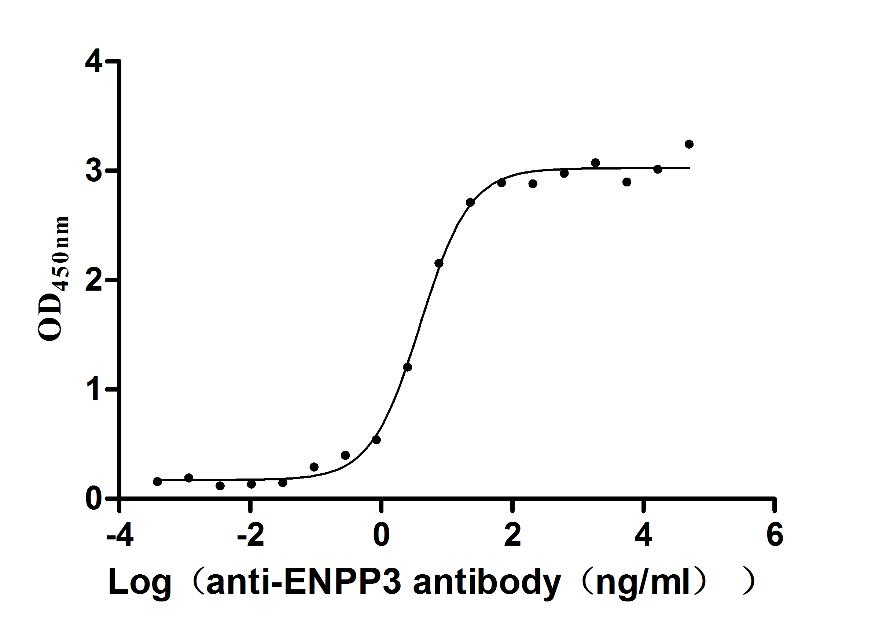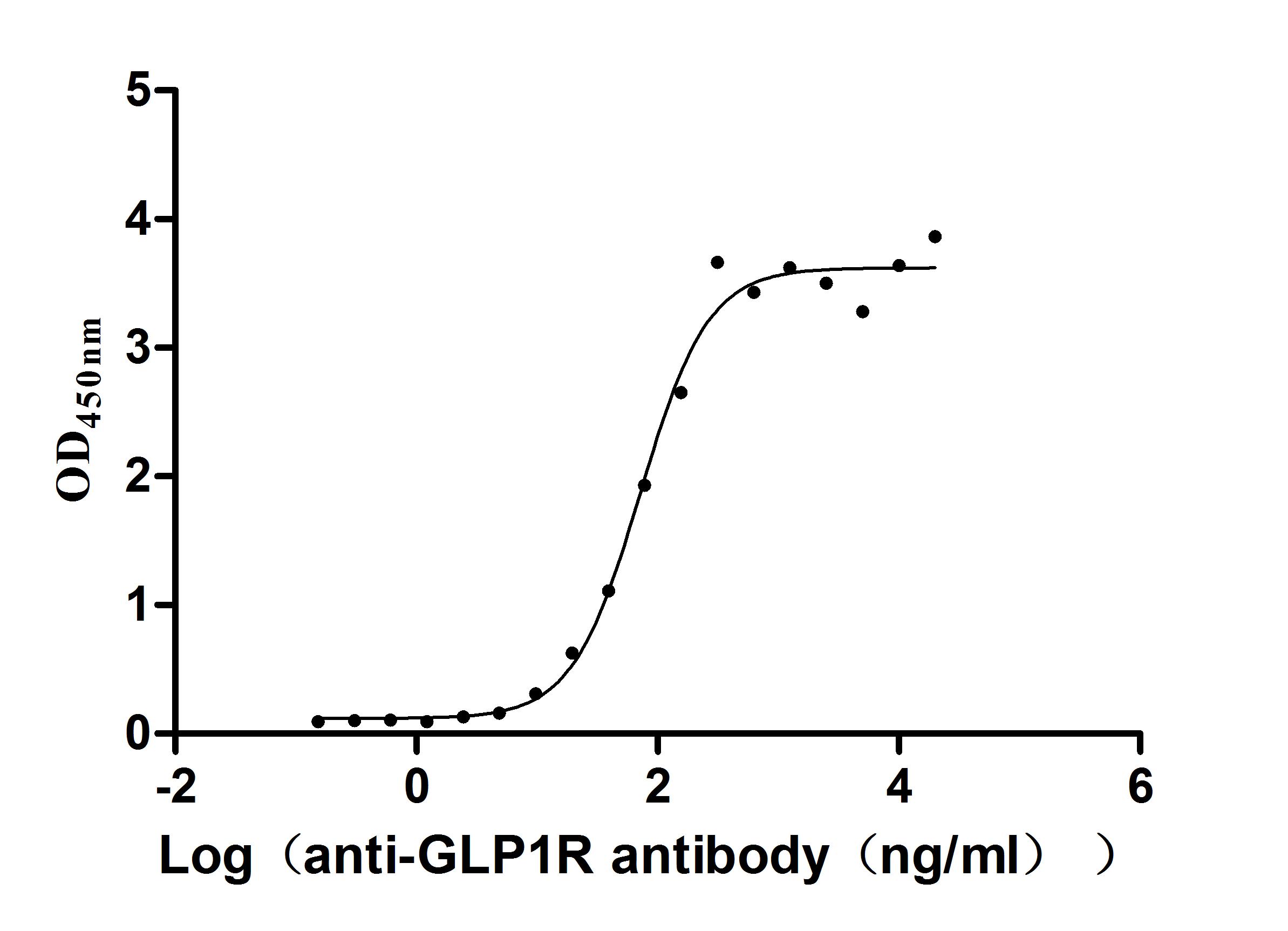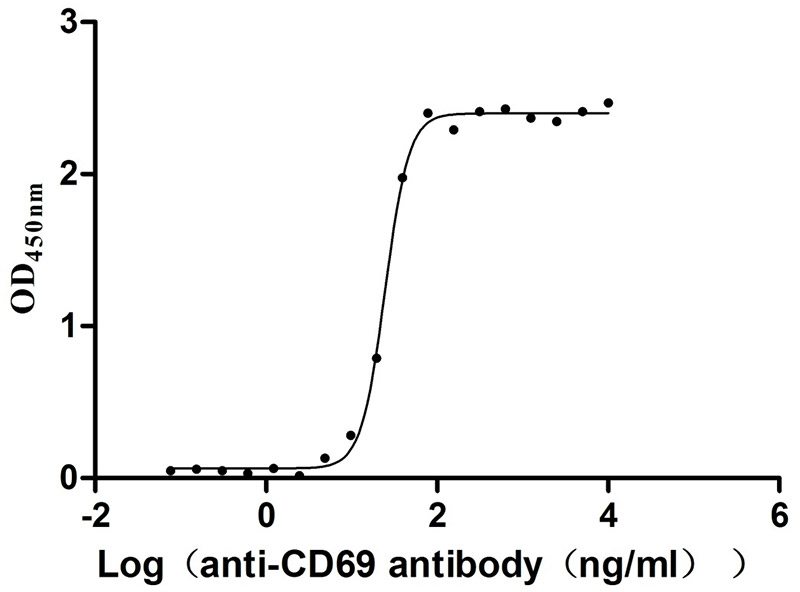Recombinant Mouse Tumor necrosis factor receptor superfamily member 4 (Tnfrsf4), partial (Active)
Unavailable-
中文名稱:小鼠Tnfrsf4重組蛋白
-
貨號(hào):CSB-AP005331MO
-
規(guī)格:¥744
-
圖片:
-
其他:
產(chǎn)品詳情
-
純度:Greater than 95% as determined by SDS-PAGE.
-
內(nèi)毒素:Less than 1.0 EU/μg as determined by LAL method.
-
生物活性:The ED50 as determined by its ability to bind Mouse TNFSF4 in functional ELISA is less than 50 ug/ml.
-
基因名:Tnfrsf4
-
Uniprot No.:
-
別名:Tnfrsf4; Ox40; Txgp1; Tumor necrosis factor receptor superfamily member 4; OX40 antigen; OX40L receptor; CD antigen CD134
-
種屬:Mus musculus (Mouse)
-
蛋白長(zhǎng)度:Extracellular Domain
-
來源:Mammalian cell
-
分子量:22.1 kDa
-
表達(dá)區(qū)域:20-211aa
-
氨基酸序列VTARRLNCVKHTYPSGHKCCRECQPGHGMVSRCDHTRDTLCHPCETGFYNEAVNYDTCKQCTQCNHRSGSELKQNCTPTQDTVCRCRPGTQPRQDSGYKLGVDCVPCPPGHFSPGNNQACKPWTNCTLSGKQTRHPASDSLDAVCEDRSLLATLLWETQRPTFRPTTVQSTTVWPRTSELPSPPTLVTPEGP
-
蛋白標(biāo)簽:C-terminal 6xHis-tagged
-
產(chǎn)品提供形式:Liquid or Lyophilized powder
Note: We will preferentially ship the format that we have in stock, however, if you have any special requirement for the format, please remark your requirement when placing the order, we will prepare according to your demand. -
緩沖液:Lyophilized from a 0.2 μm filtered 1xPBS, pH 7.4
-
儲(chǔ)存條件:Store at -20°C/-80°C upon receipt, aliquoting is necessary for mutiple use. Avoid repeated freeze-thaw cycles.
-
保質(zhì)期:The shelf life is related to many factors, storage state, buffer ingredients, storage temperature and the stability of the protein itself.
Generally, the shelf life of liquid form is 6 months at -20°C/-80°C. The shelf life of lyophilized form is 12 months at -20°C/-80°C. -
貨期:Basically, we can dispatch the products out in 1-3 working days after receiving your orders. Delivery time may differ from different purchasing way or location, please kindly consult your local distributors for specific delivery time.Note: All of our proteins are default shipped with normal blue ice packs, if you request to ship with dry ice, please communicate with us in advance and extra fees will be charged.
-
Datasheet & COA:Please contact us to get it.
相關(guān)產(chǎn)品
靶點(diǎn)詳情
-
功能:Receptor for TNFSF4/OX40L/GP34. Is a costimulatory molecule implicated in long-term T-cell immunity.
-
基因功能參考文獻(xiàn):
- Crucial role of OX40/OX40L signaling in a murine model of asthma has been demonstrated. PMID: 29344664
- Combination therapies that depend on checkpoint inhibitor antibodies (Abs) such as for PD-1 or its ligand (PD-L1) together with immune stimulatory agonist Abs like anti-OX40 are being tested in the clinic to achieve improved antitumor effects PMID: 28848055
- High Fat Diet-induced obese mice exhibit increased OX40 expression in adipose tissues and splenic T cells. PMID: 28612217
- These data support the hypothesis that the Ox40/Ox40L pathway drives cellular and humoral autoimmune responses during lupus nephritis in NZB/W F1 mice and emphasize the potential clinical value of targeting this pathway in human lupus. PMID: 28696253
- OX40 is a death receptor for invariant natural killer T cells and is implicated in pyroptotic cell death. PMID: 28436935
- this study shows that OX40 links a costimulatory receptor to a repressive chromatin remodeling pathway, and that that OX40 stimulation inhibits IL-17 and reduces experimental autoimmune encephalomyelitis PMID: 27317259
- IFNalphaR1 signaling promoted CXCL9 and CXCL10 synthesis, suggesting that these chemokines might be involved in the LPS and CD134 costimulation response. PMID: 28432083
- OX40 and ICOS act in a cooperative, nonredundant manner to maximize and prolong the T follicular helper cell response that is generated after acute virus infection PMID: 27895177
- OX40 regulates cardiac remodelling via the modulation of CD4(+) T-lymphocytes. PMID: 27580926
- bone marrow-derived mast cell (BMMC)-exosomes facilitated the differentiation of naive CD4+ T cells to Th2 cells by ligation of OX40L and OX40 between BMMC-exosomes and CD4+ T cells and represents a novel mechanism of cell-to-cell communication PMID: 27066504
- Crystal structures and NMR data show that the Roquin-1 ROQ domain recognizes hexaloops in the SELEX-derived alternative decay element (ADE) and in an ADE-like variant present in the Ox40 3'-UTR with identical binding modes. PMID: 27010430
- The OX40-OX40 ligand interaction up-regulates intracellular levels of reactive oxygen species in atherogenesis. PMID: 25115246
- OX40 was highly expressed by intratumoral T cells, particularly those of the FoxP3(+) regulatory T-cell (Treg) lineage. PMID: 24732076
- OX40 and IL-7 play synergistic, but distinct roles in the homeostatic proliferation of CD4(+) effector memory T cells PMID: 25103720
- OX40-OX40L interaction regulates the expression of NFATc1, which may play a critical role in atherosclerotic plaque formation, and may therefore have implications with pathophysiology of atherosclerosis. PMID: 24045961
- OX40 stimulation of virus-specific CD4 T cells promoted expression of the transcriptional repressor Blimp-1 and diverted the majority of cells away from follicular Th cell differentiation. PMID: 24101548
- interruption of the OX40-OX40L signaling pathway, with decreases in dietary cholesterol, induces regression of atherosclerosis by induction of IL-5-producing T cells and oxidized low-density lipoprotein-specific IgM and reductions in Th2 and mast cells. PMID: 24068673
- OX40-OX40L interaction promotes proliferation and activation of lymphocytes via NFATc1 in ApoE-deficient mice. PMID: 23593329
- These data show that OX40-OX40L signaling contributes to the evolution of the adaptive immune response to an allograft via the differential control of alloreactive effector and regulatory T cell survival. PMID: 23817421
- These results suggest that OX40 costimulation crucially engages survivin during antigen-mediated Th2 responses PMID: 23616302
- mediates responsiveness to respiratory syncytial virus in neonates PMID: 23036746
- OX40 facilitates control of a persistent virus infection. PMID: 22969431
- Mechanistically, OX40 activated the ubiquitin ligase TRAF6, which triggered induction of the kinase NIK in CD4( ) T cells and the noncanonical transcription factor NF-kappaB pathway; this subsequently led to the generation of T(H)9 cells. PMID: 22842344
- Both TNFRSF4 and TNFRSF25 independently and additively costimulate vaccine-induced CD8+ T cell proliferation following both primary and secondary antigen challenge. PMID: 22956587
- OX40 (CD134), after ligation by OX40L, assembles a unique complex that not only contains TRAF2, RIP, and IKKalpha/beta/gamma but also CARMA1, MALT1, BCL10, and PKC, molecules previously shown to regulate NF-kappaB activation through the T-cell receptor (TCR). PMID: 21282629
- OX40-OX40L interaction can regulate the mRNA and protein expressions of NFATc1 in lymphocytes of ApoE-/- mice. PMID: 21924079
- Development of skin lesions was rather more likely explained by deletion of Ikbk2 in skin keratinocytes in OX40(Cre) mice. PMID: 22363815
- following OX40 stimulation, blockade of Treg-cell suppression and enhancement of the Tem-cell adjuvant effect both concurred to free DCs from immunosuppression and activate the immune response against the tumor. PMID: 22229156
- OX40L and PD-L2 expressed on dendritic cells differentially regulate cytokine production during recall responses in the lung. PMID: 22266281
- OX40 engagement in vivo in naive mice induces initial expansion of Foxp3+ regulatory T (Treg) cells, but the expanded Tregs have poor suppressive function and exhibit features of exhaustion which can be prevented by exogenous interleukin (IL)-2. PMID: 22147766
- sOX40 inhibits MC degranulation, it may provide an in vivo therapeutic tool in allergic disease. PMID: 21653238
- Mxd4 and Mnt upregulation following OX40 engagement most likely increases T-cell survival PMID: 21400495
- The vascular OX40/OX40L system plays an important role in the formation of vasa vasorum and subsequent atherosclerosis PMID: 20584752
- Activation of OX40 augments Th17 cell function and thereby contributes to ocular inflammation. PMID: 20952591
- OX40 is a key factor in shaping Treg sensitivity to IL-2 and promoting cell proliferation and survival. PMID: 20806292
- OX40 on not only CD4(+) T cells but also NKT cells is involved in allergic airway inflammation. PMID: 20019337
- OX40 plays a key role in the homeostasis of intestinal Foxp3+ T regulatory cells and in suppression of colitis. PMID: 20368580
- find that OX40, a marker of both T cell activation and memory, is selectively upregulated in the brain during ECM and its distribution among CD4(+) and CD8(+) T cells accumulated in the brain vasculature is approximately equal PMID: 19710907
- role in activation of CD8(+) intraepithelial lymphocytes PMID: 11739485
- Engagement of OX40 enhances antigen-specific CD4(+) T cell mobilization/memory development and humoral immunity PMID: 11739496
- Dendritic cell-induced CD4+ and CD8+ T cell responses in vivo are strongly amplified when Ox40 signaling is provided through an anti-Ox40 monoclonal antibody. PMID: 11777959
- Constitutive interaction of OX40 with its ligand provides a system that plays a potential key role in the immune regulation of various autoimmune diseases. PMID: 12370402
- relative importance of CD134 (OX40) and CD137 (4-1BB) in the costimulation of CD4+ and CD8+ T cells under comparable conditions of antigenic stimulation PMID: 12516549
- The OX40/OX40L pathway has a broad importance in graft-versus-host disease induction. PMID: 12521997
- T-cell stimulation via OX40 engagement during cryptococcosis infection using OX40L fusion protein (OX40L:Ig) promotes cell-mediated immunity and IFN-gamma production by CD4+ T cells, and reduces pathogen burden in the lung and associated eosinophilia. PMID: 12794142
- expressed on memory CD4 cells; OX40-OX40L interactions are pivotal to the efficiency of recall responses regulated by memory Th2 cells PMID: 12860930
- Interactions mediated by CD134 affect onset and development of experimental allergic encephalomyelitis; Cd134-/- mice show less severe clinical signs of disease and markedly reduced inflammatory infiltrates within the central nervous system. PMID: 14644025
- OX40 signals may play a key role in mediating skin allograft rejection in CD28/CD154 double knockout mice. PMID: 14734751
- Important roles are revealed for OX40 signals in regulatory T (Treg) cell development, homeostasis, and suppressive activity, showing how OX40 signals can oppose Treg mediated suppression when they are delivered directly to antigen-engaged naive T cells. PMID: 15004159
- OX40 is one of the costimulatory molecules that can contribute signals to regulate the accumulation of antigen-reactive CD8 cells during immune responses. PMID: 15067059
顯示更多
收起更多
-
亞細(xì)胞定位:Membrane; Single-pass type I membrane protein.
-
組織特異性:Expressed in CD4(+) T-cells and in T-helper Th17 cells (at protein level).
-
數(shù)據(jù)庫(kù)鏈接:
Most popular with customers
-
Recombinant Human Leukocyte surface antigen CD47 (CD47), partial (Active)
Express system: Mammalian cell
Species: Homo sapiens (Human)
-
Recombinant Mouse Semaphorin-4D (Sema4d), partial (Active)
Express system: Mammalian cell
Species: Mus musculus (Mouse)
-
Recombinant Human Plexin-B1 (PLXNB1), partial (Active)
Express system: Mammalian cell
Species: Homo sapiens (Human)
-
Recombinant Mouse Retinol-binding protein 4 (Rbp4) (Active)
Express system: Mammalian cell
Species: Mus musculus (Mouse)
-
Express system: Mammalian cell
Species: Macaca fascicularis (Crab-eating macaque) (Cynomolgus monkey)
-
Recombinant Human Glucagon-like peptide 1 receptor (GLP1R), partial (Active)
Express system: Mammalian cell
Species: Homo sapiens (Human)
-
Recombinant Human C-C chemokine receptor type 8 (CCR8)-VLPs (Active)
Express system: Mammalian cell
Species: Homo sapiens (Human)
-
Recombinant Human Early activation antigen CD69 (CD69), partial (Active)
Express system: Mammalian cell
Species: Homo sapiens (Human)





















